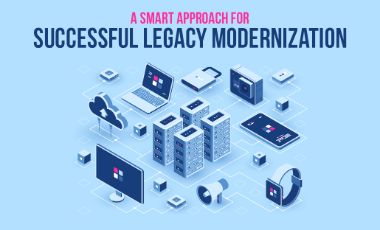Explore how to modernize legacy .Net applications and drive seamless transition and improve performance.
Blog description: Discover a comprehensive guide to modernizing legacy .NET applications. This blog outlines a step-by-step approach to enhance performance, security, and maintainability. Learn how dedicated .NET developers and legacy app modernization services can help you to streamline your transition.
The term 'legacy' usually denotes caution in the fast-paced software scene. Should your company still rely on outdated systems, you run the danger of inefficiencies, financial loss, and security flaws.
Although changing systems is a large time and financial commitment, investing more in software that has lost its edge can severely disadvantage you. Here, legacy application modernization helps guide your company back into the competitive lane with contemporary, effective IT solutions.
According to the projection, 78% of bespoke applications will be upgraded within a year since most firms seek to increase efficiency and security. (Source: https://www.redhat.com/en/resources/app-modernization-report)
But what does legacy application modernization mean, and how may it assist in getting past the restrictions of obsolete systems?
Let's delve into the intricacies of legacy .NET Framework application modernization, exploring the process and key factors that contribute to upgrading your outdated systems. We will also discuss the main advantages, difficulties, and upcoming developments.
What is a Legacy Application?
A legacy application or system is software still in use that has grown antiquated. These systems might not mix nicely with present software solutions and sometimes depend on outdated technology.
Usually monolithic, they signify that their several purposes are dependent on one another and gathered into a single platform, therefore making them rigid and challenging to change.
The following tech stacks are signs of a legacy system:
|
COBOL |
C |
Visual Basic |
.Net |
|
Delphi |
Object Pascal |
Fortran |
Perl |
Moreover, legacy applications also present the following challenges:
- Difficulties connecting with contemporary systems
- Excessive upkeep expenses
- Inadequate support
- Incompatibility with modern hardware
- Weak security
Where can you still see legacy applications in use?
They are seen in areas like government organizations handling important responsibilities ranging from taxes to unemployment benefits. Banks such as Royal Bank of Scotland still rely on these programs to handle their transactions. These systems are still running even in healthcare, where patient data is gold.
What is Legacy Application Modernization?
Modernizing old software systems is known as legacy application development. Usually, it involves moving from more modern, secure technologies to older programming languages, .Net frameworks, and infrastructure.
Using more modular architectures, such as microservices, enables companies to better fit present technology and trends. But just how would you modernize an antiquated legacy system?
Rehosting apps on new platforms, re-engineering software, code reworking, or whole program rewriting can all be part of the process. It typically uses cloud technology to improve scalability and adaptability.
Modernizing a legacy .NET application ensures the continued usefulness and relevance of your software in today's rapidly evolving digital landscape by:
- Improving system performance
- Enhancing compliance and security
- Ensuring growth in scalability and efficiency
- Meeting the evolving customer expectations and corporate needs
Why Modernize .NET Legacy Applications?
Thanks to the cloud, an increasing variety of software solutions are now readily available via the internet. These cloud-based apps are scalable, adaptable, and reasonably priced.
The cloud and the SaaS model are here to stay; even Microsoft has admitted it is time to abandon desktop-only tools.
These are some of the key reasons you should upgrade your legacy programs:
Maintenance and support: Maintenance and support expenses for legacy systems may run high. Due to their monolithic architectures and large codebases, even minor changes can pose significant challenges.
Each upgrade might therefore call for a lot of time and work. For example, the U.S. Federal Government funds IT projects with more than $100 billion a year. Over eighty percent of these costs are for operations and maintenance, mostly for older systems. (Source: gao.gov)
Legacy data must also be migrated and reorganized, as it is sometimes scattered over several databases. Besides, older systems usually rely on particular hardware settings, which increases running expenses compared to contemporary, cloud-based solutions.
Compliance and integration: Modern applications sometimes use APIs for additional capabilities such as real-time data processing or AI-powered suggestions. Due to their antiquated architecture, legacy systems find it difficult to interact with such new technology.
Integration restrictions also result in data silos, therefore compromising flawless data flow and usage. Furthermore, rigorous data privacy requirements are imposed by contemporary laws, including GDPR (General Data Privacy Regulation) and CCPA (California Consumer Privacy Act).
Often created without these security and privacy issues in mind, legacy systems find it more and more difficult to satisfy these needs. For instance, roughly 42% of companies see legacy IT as a major obstacle to reaching compliance with these rules. (Source: capgemini.com)
Insufficient knowledge: Finding qualified experts for legacy systems is more challenging as IT workers concentrate more on learning new technologies for greater employment prospects and pay. In addition, outdated technologies are not very popular in society. Modern IT professionals rely on resources found in libraries, frameworks, and tools accessible via online communities, regardless of outdated systems.
Organizations that rely on legacy solutions must therefore invest in more seasoned and often costlier senior staff, as younger and mid-level workers are less likely to interact with antiquated programming languages and systems.
Security issues: Older legacy systems expose greater vulnerabilities to hackers as they age, therefore raising the likelihood of intrusions.
One main problem is that suppliers frequently stop updating and fixing obsolete software. This makes outdated systems non-compliant with current security criteria and vulnerable to new hazards. Not only is it expensive in terms of resources, but over time, fixing these systems is useless. Every fresh patch is only a stopgap solution that won't be able to protect the program as fresh vulnerabilities keep coming up.
Constant patching drives rising maintenance costs and security threats, which emphasizes the critical requirement of legacy application modernization.
Inadequate performance and insufficient agility: Legacy programs find it difficult to scale across several platforms, particularly mobile devices, which is vital considering that a good amount of online traffic now originates from mobile users.
For example, in 2023, while 58% of website visits where through mobile devices numerous legacy systems were not optimized for mobile use.
Advantages of Legacy Application Modernization
Updating and modernizing old systems will allow businesses to access a number of advantages, including:
-
Modern systems greatly increase dependability and performance, therefore enabling faster procedures and lower downtime. This reduces possible losses and lessens handwork, therefore saving time and money.
-
Modernization enhances user experience through better client contacts that are the result of updated technology's more dependable and easy interface.
-
Modernizing can considerably reduce infrastructure and maintenance expenses. It lessens expensive patchwork repairs and lowers the chance of costly compliance breaches by better matching the present rules.
-
Modernizing legacy systems helps companies be ready for technological developments and future expansion. It guarantees company agility by laying the basis for ongoing development and adaptation to changing technological environments.
-
Modernized apps can set companies apart from one another with a competitive advantage in sectors dominated by antiquated technology. Most CEOs, according to McKinsey, give digital transformation top priority; 79% of CIOs think process change is essential to outperforming rivals. This calculated action helps companies to be creative leaders who draw in fresh business and encourage expansion. (Source: www.mckinsey.com)
Main Steps to Modernize Legacy Applications
The legacy application modernization process makes use of several approaches and best practices.
Let's explore these important phases:
-
Examine your present legacy system
Analyzing your current legacy systems in detail is a critical first step. This entails evaluating IT as well as business factors to find out how closely your legacy program fits your present and future demands.
Business factors:
-
In sync with objectives: Does the application complement your newly set company goals?
-
Value to business: How much does the application add to your company?
-
Agility: Could the application react quickly to changing corporate needs?
IT factors:
-
Cost: Is the up keeping cost sustainable?
-
Complexity: How simple is application management and upgrading?
-
Security: Does the application create any compliance concerns or security risks?
This thorough evaluation will provide you with a clear picture of the situation of your legacy systems, thereby guiding your priorities for modernization.
-
Analyze and choose the appropriate methodology
Choosing the most appropriate modernization method comes next and is absolutely essential for legacy application transformation. This choice should align with your company goals, technology requirements, and the knowledge from your first evaluation.
Here are a few tactics to consider:
-
Use APIs to make use of the data from the application on other systems.
-
Move the program to a different environment, like a hybrid-cloud configuration or the cloud.
-
Move to a new platform and make minor coding changes.
-
Update and improve already-written code to lower technical debt.
-
Change the application architecture to improve capabilities.
-
Create a fresh application starting from nothing and fit for current standards.
-
Replace the outdated system totally with a more effective one.
Select a modernizing plan that meets your particular needs and provides rapid value delivery. For some situations, easily available SaaS solutions might be enough. Custom software development may be more suited, nonetheless, for particular demands or to incorporate unique features.
-
Develop your .NET modernization strategies
When determining the extent of your .NET app modernization strategies, give simplicity and utility a priority. Many times, complicated designs of legacy systems compromise performance. Modernity calls for you to:
-
Pay attention to important characteristics: At first, combine just the most important aspects.
-
Accept microservices architectures: For scalability and adaptability, think about a microservices modernizing strategy.
-
Check compatibility: Make sure the revised program fits very nicely with current corporate tools. If you want to replace these instruments, consider the needs of potential substitutes.
-
Simplified design: Simplify the design to increase maintainability and lower complexity, therefore enhancing general performance and the user experience.
-
Examine your technology stack and data set
Delivering the best performance and user experience depends on choosing the correct technological stack. Here are some actions:
-
Assess present needs: Analyze the particular needs of your product to choose the most appropriate technological stack.
-
Meet consultants: Talk to your IT staff or consult expert tech consultants to get ideas on the ideal technology to apply.
-
Foresight: Choose a technological stack that not only satisfies present requirements but also is scalable and flexible for further developments.
-
Quality control: Implement robust testing and quality assurance procedures to ensure the dependability and effectiveness of the updated application.
-
Create your team
This phase should see you assembling department heads, operations leaders, and IT experts. This guarantees a comprehensive modernization path for your .NET legacy applications. Involving team members at different levels helps to guarantee that the team runs at its best by encouraging responsibility and therefore lowering opposition to change.
For easily maintained code, you should also follow internal procedures and coding standards. This will guarantee comprehensive documentation for the next system expansion, facilitating the understanding, extendibility, and maintenance of the program.
-
Set up your timeline and specify the increments
Modernizing is not a quick fix, so it's important to understand this. Rather, it calls for rigorous preparation and execution. The intricacy of your project and the chosen modernizing strategy should dictate the length of every phase.
Developing this chronology is only one aspect; another is defining the exact success criteria. They will be like road signs, guiding you at every level to evaluate the success of the upgrade.
-
Design customer training and adoption programs
Changing to a modernized legacy application requires careful planning for your customers' adoption and training of these new solutions. One useful tool in this process is a DAP, or digital adoption platform. DAPs provide end users with a range of capabilities, like guided onboarding tours, interactive step-by-step routines, and in-app assistance, therefore smoothing down their transition.
Additionally, take into account setting aside money for:
Employee training: Workers used to the previous system might need direction to make effective use of the new one.
Regular system updates are required to maintain the updated system's performance and relevance.
Challenges to Modernizing Legacy Applications
A key first step towards technical development is modernizing old programs, although it is not without challenges.
-
Learning curve: Switching from old to new systems might be challenging. This change calls not just for technological upgrades but also adjustments in everyday activities that can cause opposition or slower acceptance rates. You may need sufficient training and ongoing assistance to overcome this challenge.
-
Code complexity and skills gap: Modernizing complicated legacy code calls for knowledge of more past technology. But there is a dearth of such personnel to help you migrate your legacy .NET applications as experts move to more modern tech stacks. As a result, finding the appropriate skills for reworking legacy code is becoming more difficult.
-
Data access and security: Legacy modernization depends critically on the assessment and management of security, operational, and financial risks. Cleaning and organizing current data is also essential to make sure it fits new corporate goals and does not introduce legacy mistakes into the upgraded surroundings.
-
Costs: Modernizing legacy applications means balancing long-term returns against current expenses. We must make decisions about whether to completely revamp systems or update specific elements, considering the expenses of new infrastructure, training, and transition-related interruptions.
Conclusion
Ultimately, companies trying to remain competitive and take advantage of the most recent technological developments must first modernize legacy.NET programs. Following a methodical strategy can help you guarantee a seamless transition, improving performance, security, and maintainability. Whether your requirement is for specific and decicated .NET developers or whole legacy app modernization services, working with professionals like Clarion Technologies will greatly expedite the process and produce remarkable outcomes. Trust and propel your company ahead to embrace the future of.NET apps.








